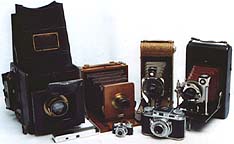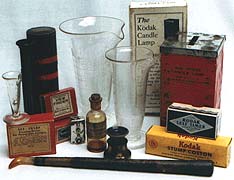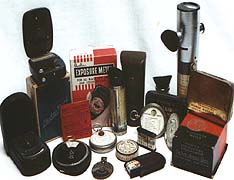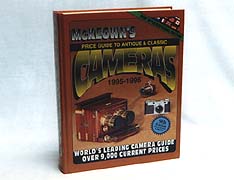Copyright © 1996, 2002, David Silver.
BUYING CLASSIC
CAMERAS V
A Neophyte's Guide to
Collecting Photographica
by David Silver
|
There's no explaining the collecting phenomenon. From the earliest days of civilization, people have been motivated to spend their idle hours assembling, categorizing, researching and cataloging all manner of things. Today we all know friends or relatives who collect in their spare time. Stamps, coins, comic books, baseball cards, autographs, and even butterflies are probably some of the more common areas of interest. In this article, however, we'll examine one extension of collecting, one vast specialty encompassing a myriad of others, that is slowly gaining popularity around the world. Antique and classic cameras, photos, photographic apparatus,...in a nutshell, collecting photographica. | 
Finding antique and classic cameras is fun and easy, but choosing your own specialty can be a puzzle! |
"Photographica" is the general term we use to describe all the various artifacts involved in the history of photography. From the vintage books where old time photographers once learned their trade, to the antique and classic cameras that took the pictures, to the archaic processing equipment that brought the images to life, and to the very photographs themselves. In the brief space allotted here, I hope to expose a bit of this complex world for your appreciation. Along the way we'll also investigate a few strategies for hunting out these collectibles, explore ways to research whatever you find, and learn where and how to meet other photographic collectors.
Of course, the question beckons, why bother collecting photographica in the first place? Certainly, if you are holding this magazine or reading this article on the internet, you already have a general interest in photography. You appreciate the mechanical mysteries of the camera and admire the power of the well-visualized image. However, when you leave behind your comfortable world of auto-everything do-it-all cameras and peek back into photography's history, you quickly see there are many more things to learn about photographers and processes and apparatus than you had originally suspected. Is your "general interest" reason enough to start collecting? It can be, but there are other good reasons as well.
For example, the history of photography is "neat" in that the first processes were clearly defined and introduced in 1839. Therefore it is a field with a distinct beginning and its history is recent enough so that any neophyte can quickly get a grasp of its general extent. And photography offers incredible diversity throughout its fabric, in both process and product, creating endless opportunities for the discerning collector to find a specialized niche. Also, photography represents that rare synthesis of art and science, esthetic values combined and compressed with mechanical and chemical achievements. While they may not always realize it, those who collect photographica are also collecting relics of an historically significant scientific and artistic heritage. Lastly, of course, for the "evil" speculators among us, the collectible market usually beats the heck out of inflation over the long haul. However, I think the best reason to collect cameras and other photographica is the endless fascination, the unique charm, and the simple fun of it all!
What to Look For:
Once the collecting bug bites, there's no telling where your interests will lead you. Most advanced collectors of photographica admit that at one point or another they found themselves buying anything that was remotely connected to photography. This isn't necessarily a bad thing, but it's really only an advantage if you have unlimited resources and the space to maintain it all.
However, reality usually rears its ugly head and dictates that you confine your habit to some logical collecting goal or principal interest. This isn't to say that you have to "limit" your collecting, but merely give it some focus. For example, my special interest lies in nineteenth century cameras and apparatus, preferably made in America, with a few choice examples of the images from that period to illustrate the final product.
So, how focused should your collecting be? That's for you alone to decide. Looking at cameras, for example, you might only be interested in East German 35mm products. How about German cameras of any type or format, or just those made by Zeiss Ikon? Japanese products in general, or 1950's Nikon only, or rare pre-war Olympus, or anything from Kuribayashi's stellar 90-year reign? Do you like miniature cameras? Or would you prefer rare and unusual "spy" cameras? Perhaps you like Kodak folding cameras? Perhaps you only like Kodak folding cameras made in the 1930's? Or perhaps you specifically like fine German folding cameras from the Nagel Kamerawerk made in the 1930s for distribution by Kodak? You see, each specialty can lead to a further subordinate specialty, or just as easily branch out to another area. Of course, if you prefer the truly antique, you can choose from those grand formative years of camera evolution in the nineteenth century. For the mad, screaming zealots among us, all of these probably sound appealing, but the point is that the possibilities are endless. Get the picture?
Speaking of pictures, you may want to collect these, as well. Daguerreotypes, ambrotypes, tintypes, carte de visite, cabinet cards, stereo views, or the famous images taken by the acknowledged masters of the field. Record prices have recently been paid for particularly fine examples of Daguerreotypes produced by a few important photographers, but there are still plenty of excellent portraits and simpler views available at bargain prices for the beginning collector.
Ambrotypes, while not as desirable right now as Daguerreotypes, are actually harder to find in pristine condition, and I feel market prices in the next few years may reflect this. Stereo cards, on the other hand, depending on image subject and photographer, have always been a volatile market. However, whatever your specialty, if your interest lies in photographs, of any type or vintage, I highly recommend that you aggressively enter the fray now, before the art and history collectors price us right out of the market. Even for people who have no interest in the process, photographic images represent the only truly objective and esthetically "pure" view of our world and will always command a value beyond their simple beauty and mesmerizing charm. [The author notes in 2002: "Since I wrote this article in 1996, the prices for rarer quality antique images have indeed spiked upwards. Record returns for Daguerreotypes and ambrotypes from the big auction houses and popular venues like the MPM Image Show in California continue to make news in the art world. However, the market for more typical quality images has not yet escalated beyond the means of beginning collectors. There's still time to join the hunt!"] |

A selection of necessities for the "modern" darkroom! | Of course, photography is not represented by cameras and images alone. There's an entire supporting cast to consider, a vast world of accessories and extras, that offers so many more opportunities for collectors. For example, consider all the things you might find in the well equipped vintage darkroom and how unusual some of them may seem to photographers today. Plate drying racks and developing tanks; mercury fuming boxes and iodine sensitizing apparatus; burnishers and brushes, beakers and bottles; safety lamps and stump cotton; framing masks and early enlarger focusing devices and wooden printing frames. And because of the esoteric nature of many of these items, the price and condition is often a very pleasant surprise. |
As any modern photographer knows, the contemporary market is glutted with every imaginable accessory and aid for capturing that elusive "perfect" picture. That's hardly news, however, as the collector can hope to find accessories dating clear back to the very beginning of photography. Filters, tripods, view finders, self timers, cable releases, framers, vignetters, and flash devices are just a few examples. I have seen some absolutely amazing collections of exposure metering devices numbering hundreds of items and still growing. And let us not forget the "software" of photography, the film, which over the years has taken many forms, from silver plated copper sheets to gelatinous coated glass plates to flexible strips wound on spools or inserted in cassettes. | 
Trying to find the right exposure? With a collection of meters like these you'll never have to worry! |
Whatever your eventual interest or specialization, I want to emphasize one important strategy for you. Always insist on the best possible condition. Believe me, you don't have to settle for an item that is in "good" condition "considering its age", because in photographic collecting there is no such qualifying statement. If you feel you must buy an item in less than excellent condition, and this happens far more frequently than we want to admit, it's not the end of the world. We all resort to impulse purchases at times. Consider them opportunities to test your mettle and maybe even learn a little bit about repair. However, try not to invest too much in these "opportunities" because you won't always find another collector willing to trade for or buy such items for the same price. Shop smart and compare. Take notes. Haggle with people. Ideally, whatever you choose to collect, do it out of joy and never out of a sense of obligation or necessity. Have fun!
Where to Find It:
I believe the best place to begin your search for photographic collectibles is in flea markets and "junky" antique shows and swaps. Cameras and photographic apparatus are common items, and, despite the exquisite nature of much of the older material, don't often break into the snobby circle of "fine" antiques. While I wouldn't totally ignore the fancier shows, I would definitely give more attention to the friendly confusion of weekend swaps.
Your next option is your local newspaper's classified ads or any free advertising papers that may be available in your area. Don't just look at the photography section. Check the antique and collectibles sections, the miscellaneous section, and pay special attention to garage sales and estate sale listings. Get the papers as soon as they hit the stands and be the first person in line for any sales.
Thrift stores are wonderful. The people there are usually very friendly, the prices are right, and the money often goes to good causes. Best of all, they tend to give the customer the benefit of the doubt and are usually willing to haggle. Trade phone numbers with them and ask them to give you a call whenever more photo material comes in. If you offer to help them identify and value things, you may even get the chance to "preview" materials before they are presented to the public. Don't abuse such a privilege by tendering spurious advice, however, or you will quickly lose your advantage. Honesty is the best policy.
Antique dealers, because of their irritating habit of pricing things according to their own "market sense," are rarely worth establishing relationships. However, it may still be a wise investment, if the opportunity comes, to buy a couple of dusty old box cameras out of a front window to soften up a dealer for future negotiations. In the meantime, it's better to watch for auction announcements, photo supply stores offering super sales on "out of date" and used goods, and small local photo swaps at schools or studios. While these sources inevitably deal with used or usable materials, the occasional classic item is certain to surface there. You can also make contacts with people who frequently handle photographica, both dealers and buyers, and create productive relationships.
Lastly, there are the major photographic shows, mostly operated by the many photohistorical societies around the country. Unfortunately, since they are now mostly populated by used and usable camera dealers, I can only give them a qualified recommendation. While there are amazing things to be found there, after you wade through all the other "stuff", the bargains are now few and far between. Many of the dealers are sharks and know their waters well. It can be intimidating, especially to the new collector. However, this may be your best chance, outside of joining a club, to meet other collectors. When you do, you'll hear stories, make deals, learn about the "good old days" of photographica collecting, understand the market a little better, and probably make a few friends for life. So, if you choose to swim in these waters, stay in the shallows, don't get bitten, and maybe I'll see you there! [The author notes in 2002: "This article was written in 1996, so there is no mention of the internet auction services that were just starting up around that time. These have had a profound effect on the more traditional collecting venues, most especially the shows, but all my advice still holds true. In general, the internet auctions are fun to watch and provide a considerable market for the knowledgeable collector, but they can be very dangerous for the neophyte. Too much, too fast, and usually improperly represented! Stick to the tried and true markets until you develop a discerning eye and your own well defined collecting parameters."]
How to Learn More About Photographica:
Okay, so you've seen it, you've fallen in love with it, and now you've collected it. How, you might ask, do you then learn more about it? Well, for anyone who wants to become truly expert in their collectible field and learn the most they can about what they are acquiring, I can recommend two major categories of support.
First of all, books, books, BOOKS!! I can't stress this enough! You must accumulate and maintain some sort of small library about photographica and the history of photography. Believe me, your happiness depends on it! It doesn't take much, and it doesn't have to happen over night, but it may be the wisest investment you can make in support of your collecting. |
To start with, if cameras, absolutely any sort of cameras, are your main interest, run, do not walk, to find a current edition of McKeown's Price Guide to Antique and Classic Cameras. It's not just about prices, so don't let the title fool you. This is the single most indispensable guide to all things concerning cameras. While there are other "price guides" out there, this one is much, much more. Don't argue with me, just buy it! Not only that, Jim and Joan McKeown are responsible for many other superb specialty books on specific camera companies and lines. Contact the McKeowns directly at Centennial Photo Service at 11595 State Road 70, Grantsburg, Wisconsin 54840 for more information on all their fine offerings. [The author notes in 2002: "The current McKeown's Price Guide is the 11th edition and dated through 2002. It lists over 25,000 cameras with over 6000 photos! Unbelievable!!"] | 
For many camera collectors, McKeown's Price Guide may be the only book they'll ever need! |
Since collecting photographica is still a relatively small field with a limited readership, there are a number of excellent books that are currently out of print. Fortunately, they are occasionally made available through specialty houses and photo swaps, and they are definitely important enough to look up in libraries. George Gilbert's Collecting Photographica from 1976 wasn't the first book on the subject, but remains one of the best and is an excellent introduction to the field. William Welling's Collectors' Guide to Nineteenth Century Photographs, also from 1976, is the perfect starting point for those interested in classic images. A Century of Cameras, by Easton S. Lothrup, revised in 1982, is another indispensable source for the camera enthusiast. However, perhaps the finest book yet published specifically on the history of the camera is Brian Coe's Cameras from 1978. Incredibly, instead of photographs, the book is completely illustrated with magnificently detailed drawings!
Obviously, I could go on and on to list many more books, but, for a current listing of new and some not-so-new books on the history of photography, I highly recommend you contact Bill Carroll for a catalog at ACR Books, 8500 La Entrada, Whittier, California 90605, or call (310) 693-8421. Bill maintains a wonderfully diverse selection and his prices are always reasonable. [The author notes in 2002: "Bill Carroll continues to sell used and out of print books privately, so he is certainly worth contacting. However, I believe the absolute best source of new books in this field is Petra Kellers who purchased ACR from Bill a few years ago. Visit her web site at http://www.camerabooks.com or call her business in Boulder Creek, California, toll-free at (888) 338-1350. Tell her I said hello!"]
As for the other category of support for the fledgling collector of photographica, I would like to mention collectors' societies and photohistorical organizations. There are many throughout the United States and a number of them have been running well over 25 years. Some represent precise geographic areas, like the Ohio Camera Collectors and the Chesapeake Antiquarian Photographic Society. Others represent particular interests, such as Kodak or Leica. A few produce excellent periodicals, notably the Western Photographic Collectors Association and the American Photographic Historical Society. [The author notes in 2001: "Sadly, the WPCA ceased operations due to a sizable drop in active membership in the southern California area. Their fabulous journal, The Photographist, Mike Kessler's labor of love, was lost as well. Fortunately, other groups, including a few new ones, are still running strong all over the world."] However, they all offer friendship, common interests, unusual resources and opportunities, and a wealth of information on the history of photography.
Finally, to bring it all together, I offer the services of my own group, the International Photographic Historical Organization. Founded in 1985 as part of a collaborative effort to create a museum of art, science and technology, InPHO continued on its own and has served as a corresponding resource service for all people interested in the history of photography. While InPHO doesn't maintain a membership, like a club or society, we do register any groups or individuals willing to share their expertise in a worldwide database. Our eventual goal is to produce a comprehensive directory of collectors, societies and resources pertaining to the field. In the meantime, InPHO is always there to help anybody seeking information on any aspect of the history of photography. InPHO can be contacted by e-mail at silver@photographyhistory.com, by old fashioned "snail mail" at P.O. Box 16074, San Francisco, California 94116, or call us direct at (415) 681-4356. We can assist with research, verification of historical information, peer review of new literature, aid in finding other collectors in your area, identification and appraisal of items you have acquired, sales support, and occasional consignments. Send us a SASE and we'll provide you with a free listing of all the photographic societies currently in operation.
So, now what are you waiting for? You mean you're still not sure about venturing into the wonderful world of collecting photographica? No problem. We can fix that for you. Just give us a call! We love twisting arms! |
Copyright © 1996, 2002, David Silver. All rights reserved.
This article first appeared, as edited here from a longer original manuscript, in the February 26, 1996, issue of Photo Shopper magazine. If you'd like to reprint the article, purchase secondary rights, or discuss the possibility of acquiring new articles, please feel free to contact the author at silver@well.com, thank you!
BACK to the International Photographic Historical Organization contents page!
GO TO the International Photographic Historical Organization home page!
CONTACT the author, David Silver, for more information!
|



